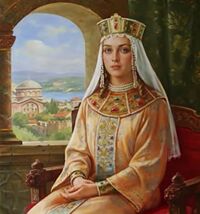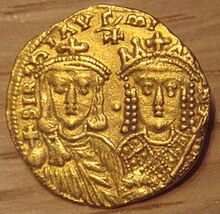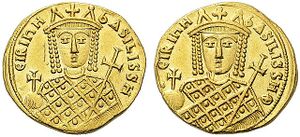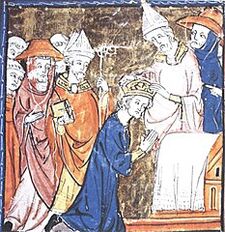Irene

Irene of Athens (c. 752 – 9 August 803), which is a damn sight easier to say than Irene Sarantapechaina, was, at various times starting in 775, a Byzantine empress by marriage to Leo IV, regent, co-regent, empress regnant, empress pregnant, and supreme leader without title.
A member of the prominent Sarantapechos family, Leo IV picked her for his bride for unknown reasons. Leo IV was an iconoclast, though when Irene got the throne all to herself, she convened the Second Council of Nicaea, which called iconoclasm a heresy. The regime went from pulling down statues of Jesus and the saints, to condemning those doing it.
Irene's son, Constantine VI, gradually stopped being such a mama's boy, and there were several movements in the 790s to have him replace Irene as full emperor. The movements stopped when she poked both his eyes out, and his movements stopped a couple of days later, putting Irene totally in charge.
That did not settle things. Pope Leo III ruled that a woman could not be emperor and therefore Charlemagne was the real emperor. Irene ignored him; but in 802, the revolts resumed and Irene was overthrown.
Family matters[edit]
Constantine V brought Irene to Constantinople in 768 and married her to his son, Leo IV. It baffles historians why she was selected, as she was not "a looker" and probably did not put out either. Moreover, Constantine was an iconoclast, aggresively persecuting those who venerated icons, while Irene thought they were "kind of cute," and before long had more of them decorating the pantry and hutch than most Oklahomans have Avon figurines. It cannot have been a marriage made in heaven. And she did not have a lot on the ball, either. In 771, she gave birth to a son but the muse abandoned her and the only name she could come up with was Constantine VI. That labour seems to have dissuaded her from attempting further childbearing.
Nevertheless, when Constantine V died in 775, Leo IV ascended to the throne, and Irene ascended to the upper steps next to the throne, the empress consort of Byzantium. Mercifully, Leo was not as much an iconoclast as his father had been. He repealed some penalties his father had decreed, and even appointed Paul of Cyprus to be his successor, provided Paul promised not to bring any more of the cloying figurines into the palace. In 780, however, Leo had a relapse upon finding several icons underneath Irene's pillow. Envisaging a rougher night even than that described in The Princess and the Pea, Leo discovered which of his trusted aides were responsible for this particular stuffing, and had them arrested and tortured for venerating the damned things. Irene insisted that she had no idea the icons were there, and slept as well as always; but Leo refused to have sex with her after that.
Regency, or maybe more[edit]
Leo didn't have to keep his promise for long because, by September, the only erection he was getting was rigor mortis. Constantine VI became emperor at the age of nine, with Irene in actual control of all the levers of power.

It took only six weeks for a conspiracy to arise to replace this duo with Caesar Nikephoros, Leo's half-brother. Irene had three of her courtiers scourged, tonsured, basted, fricaseed, and banished; replacing them with more loyal men. Nikephoros himself, she made a priest; this sounds like an honor but it conveniently disqualified him from becoming Emperor.
Apart from the scourging and tonsuring, there were other hints that Irene had in mind being more than a mere facilitator for her son the Emperor. Irene's defensiveness may have reflected her understanding of what happened to the last regent, Martina, who was exiled to a sunny island after less than a year, with her tongue remaining behind.
The next rebellion Irene had to quash was by Elpidius in Sicily. Irene sent a fleet, which defeated his, but Elpidus himself fled to Africa and joined the Abbasid Caliphate. They returned with a vengeance in 782, took Anatolia, and only agreed to retreat for three years for a large payment and plenty of booty and snacks.
With Leo and the other iconoclasts dead or banished, Irene inevitably restored the veneration of icons. Kewpie Dolls, Raggedy Ann and Andy, and prizes found inside boxes of Cracker Jack began to appear throughout the realm. Irene summoned two church councils, where like any good lawyer, she knew the answers she wanted long before asking the questions. The second of these, at Nicaea in 787, was the Seventh Ecumenical Council. Once it became clear it would be a success, it got the more high-falutin title of the Second Council of Nicaea. This council not only revived veneration of icons but reunited the Eastern Church with the Church of Rome. Finally people throughout Europe could get one-stop absolutions at the drive-up window.
Too big for her britches[edit]
Constantine eventually grew beyond popping pimples and wanted to govern in his own right. Irene crushed this attempt and afterward demanded that oaths be taken in her name alone. This was too much for the military class, which in 790 proclaimed Constantine the sole ruler. Dramatic stuff, given that it had no effect. Constantine and Irene continued to exchange stiff pleasantries, like American Senators praising the Gentlemen on the other side of the aisle while they leak each other's off-color jokes to The New York Times.
Mother and son were proclaimed "co-rulers" again in 792, but the entire government took sides and cunning intrigues started taking place. By 797, Constantine fled to the provinces, but partisans of Irene brought him back to the palace, where Irene poked out his eyes, and probably plenty of his brain too, as Constantine died of his wounds within days. Irene was finally Number One.
Good night, Irene[edit]
In Western Europe, however, Charlemagne was flexing his muscles in the so-called Carolingian Empire. He invaded Italy, captured the Lombard kingdom, fought the Saxons of northern Germany, and defeated the Avars. In 800, the Pope declared Charlemagne a Roman Emperor by crowning him in St Peter's. From now on Popes decided he was an emperor or not, at least in the West. Charlemagne then sent a marriage proposal to Irene with the express desire to 'reunite' the Roman empire as one political body. Both were in their 50s so it would be one last fling for the pair of them. Whether Irene seriously considered the offer is not known but it was enough for the Byzantine power brokers to move on her. Irene was stripped of power and exiled to the island of the Lesbians. The patricians selected Irene's treasury minster Nikephoros I to succeed her. She was given a villa on Lesbos and died a year later. Irene got to keep her eyes and tongue.
Aftermath[edit]
To the Byzantines the idea that the people who had destroyed the Western Roman Empire four centuries earlier could now 'restore' it under the power of a pope was considered an act of treachery. But the Byzantines had no army they could send to Italy to chase the Franks out.
| Preceded by: Leo IV |
Byzantine Empress 780–802 |
Succeeded by: Nikephoros I |



